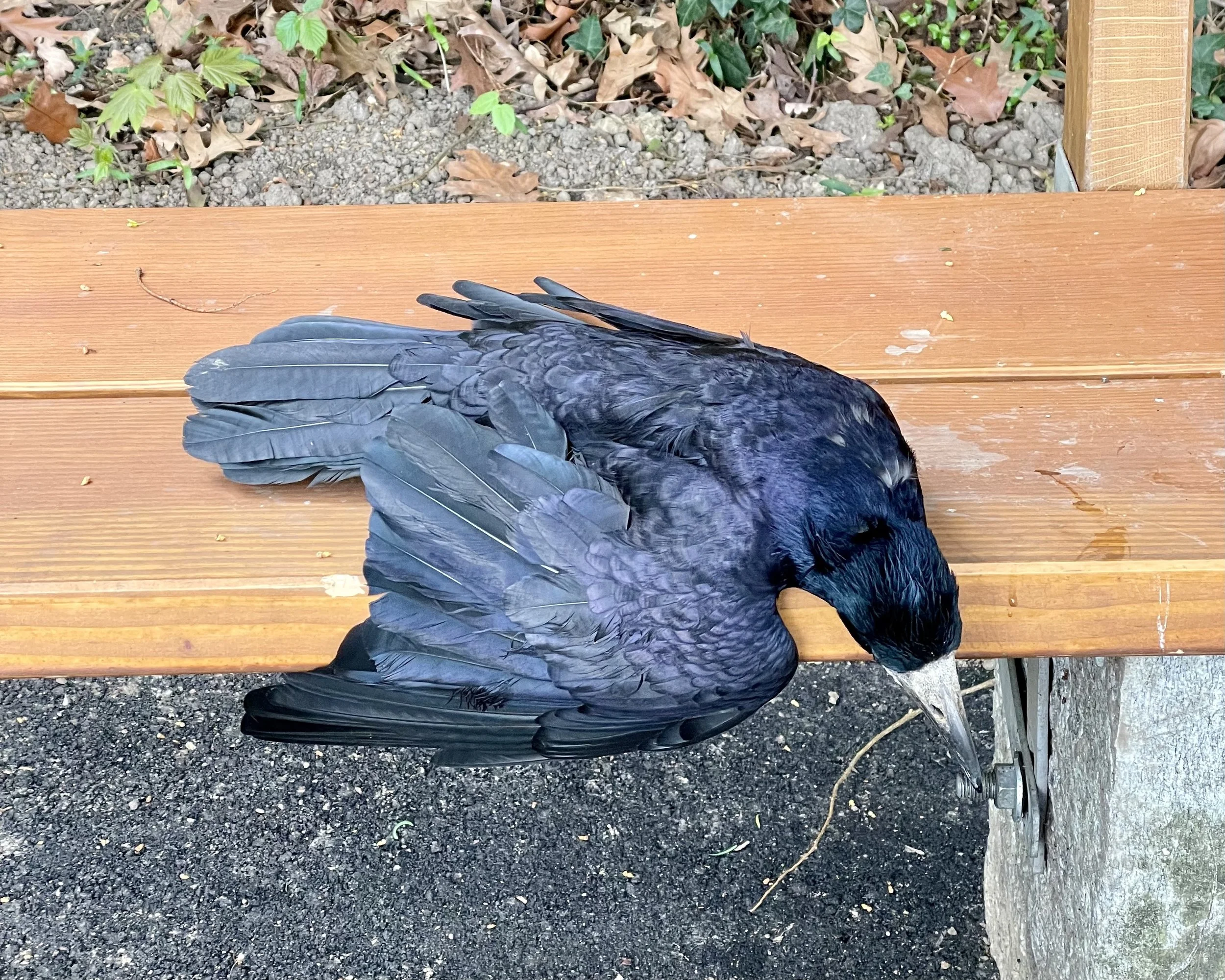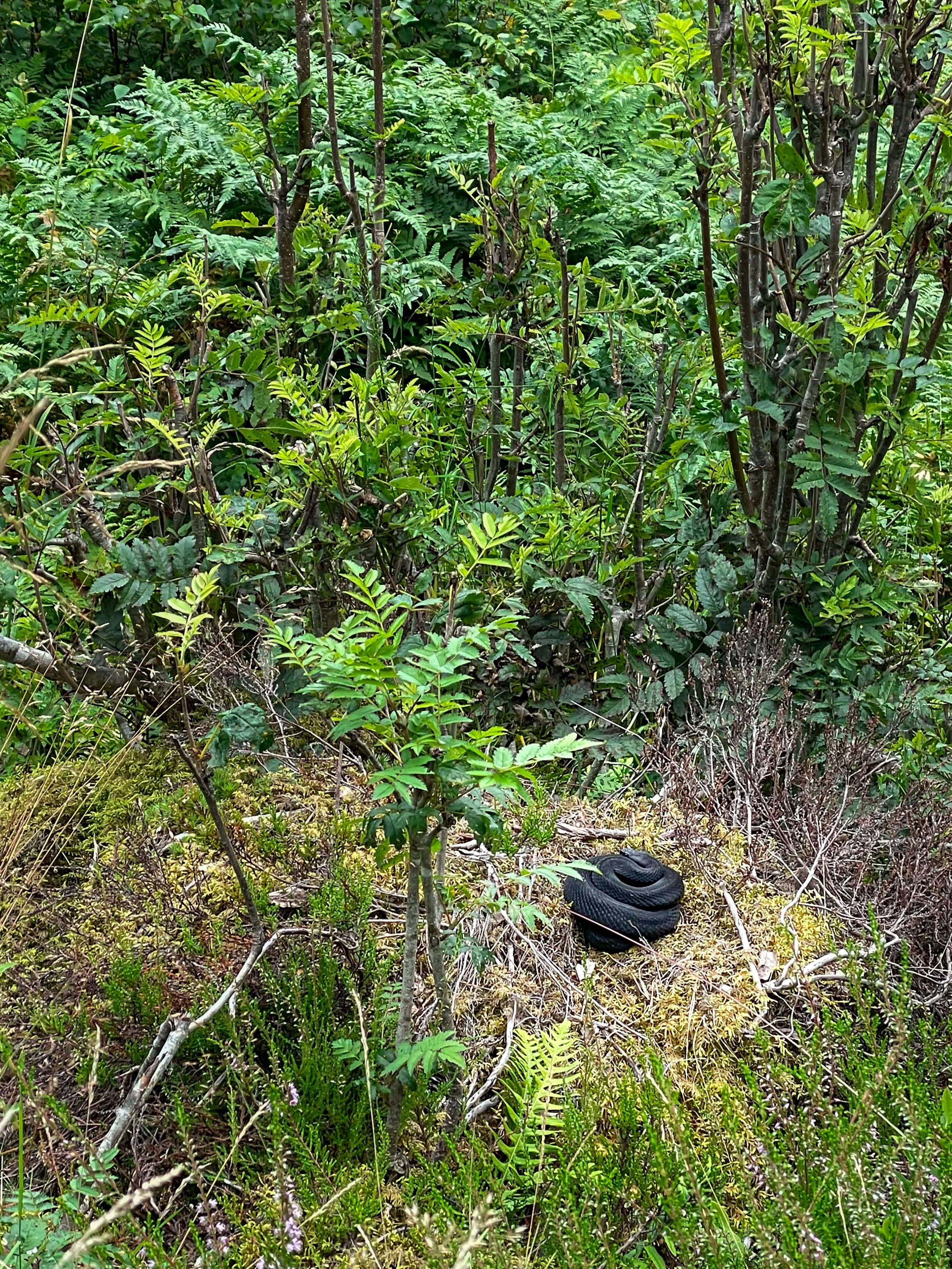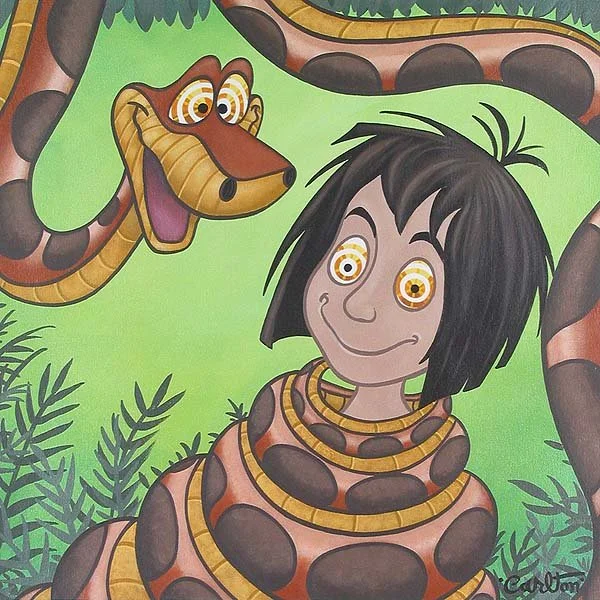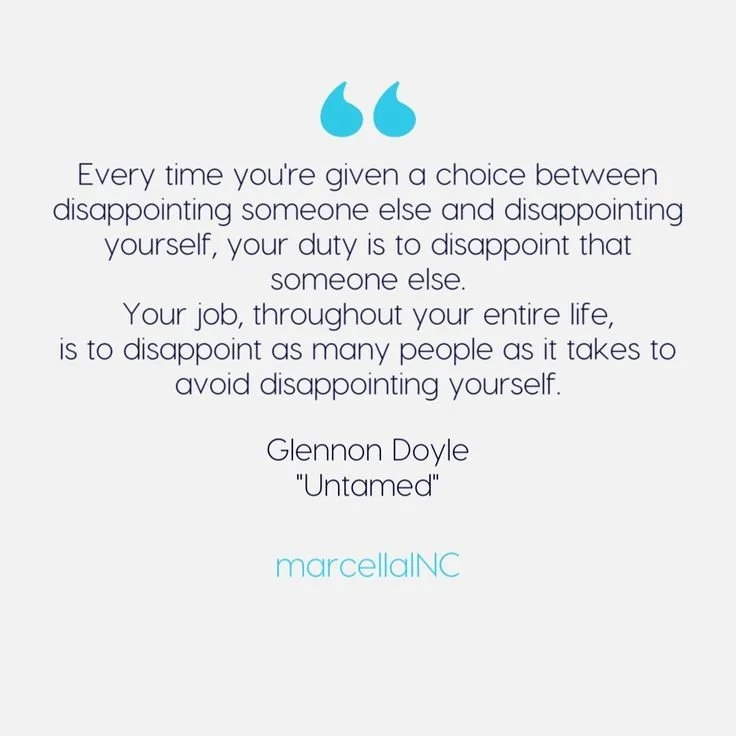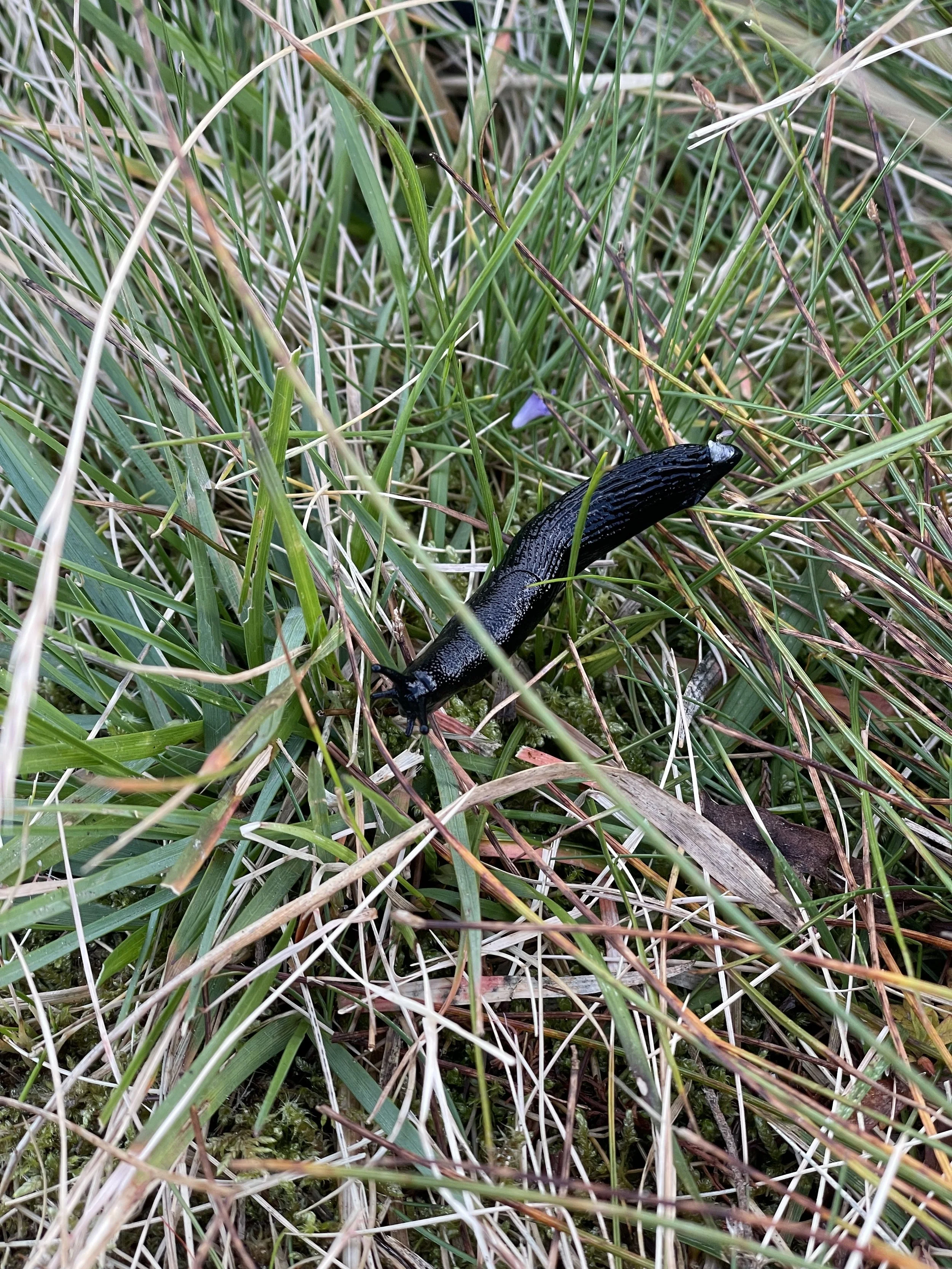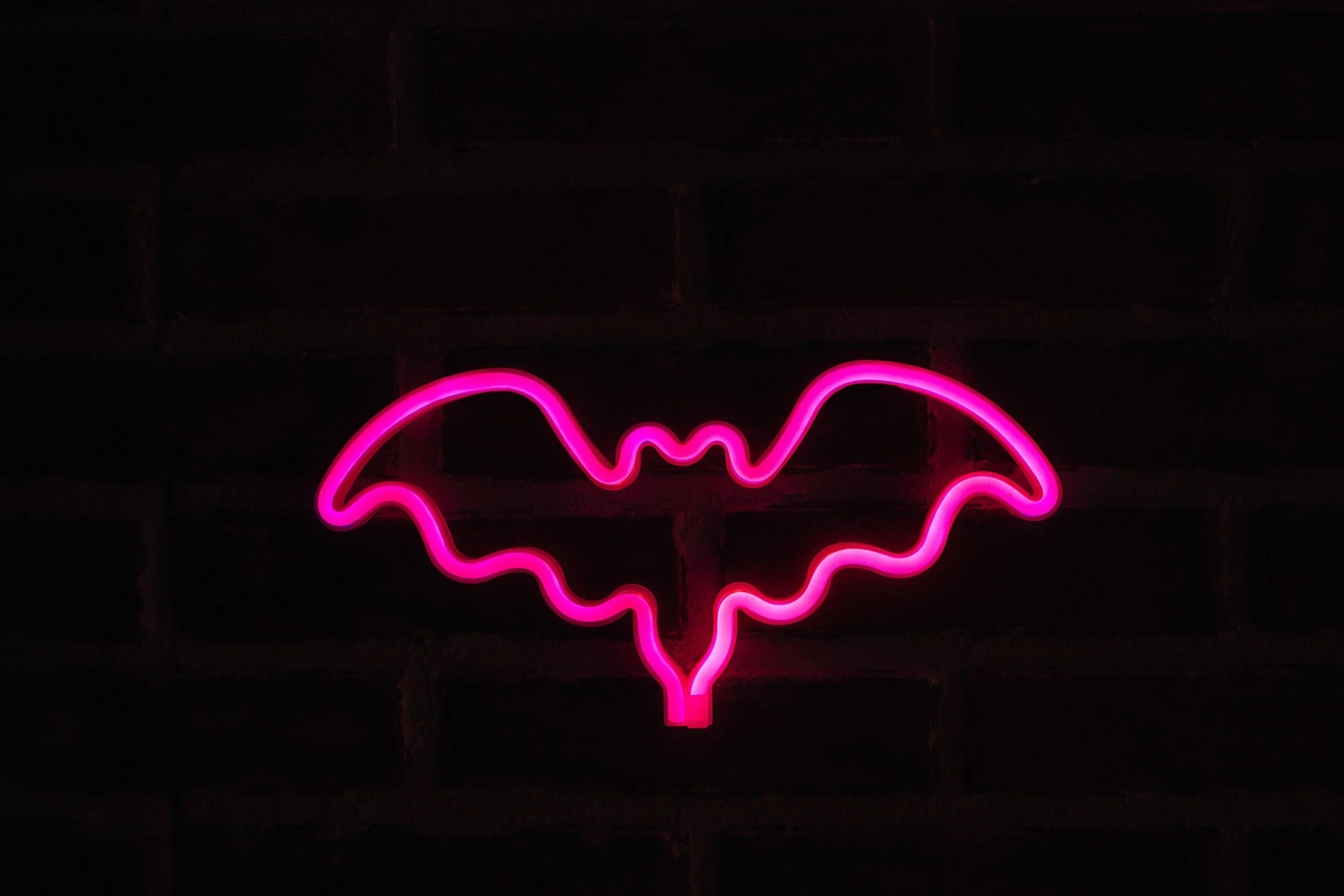Black Animal Messengers: Whispers of Shadow and Intuition
Last year, on a damp Spring day in April, while walking in a park in Basel, Switzerland, lost deep in a swirl of ruminations, I came across something startling along the walking path. In front of me on this lonely, solitary trail was a wooden park bench with a perfectly positioned black crow, dead. I looked around. There was no one to join me in the witnessing of this sight. It was remarkably beautiful—the black feathers giving off a purple-tinged sheen in the haunted light filtering through the overcast sky. The feeling was quite ominous.
But mostly I was bringing that aura with me—you see, I’d just gotten off a remote Zoom call with my therapist, Melanie, in Boston, in which I’d shared that I felt uneasy about the plans I’d just made, inviting a dating app date to fly from Madrid to Zurich to meet up. I didn’t know why I felt uneasy, and she couldn’t quite convince me in that one session alone to maybe listen to my intuition.
The truth was, I wasn’t listening much to my intuition at all and didn’t even have the awareness to know what I wasn’t hearing, what I wasn’t knowing. In this particular instance, I’d been enthusiastic upon talking with him a few times over FaceTime, but then after he booked his flight and we talked again, something seemed wrong.
He suddenly had a childlike giddiness to him that was off-putting. He tried to get me to meet his pre-teen daughter over FaceTime. I can look back now and say “leaky boundaries”. But I didn’t quite get it until after we spent a weekend together, which wasn’t horrible but also not great. He wanted things to be serious too quickly. He couldn’t read me but interpreted his projections as my qualities.
One of the days of his visit, on a hike up a mountain (when in Switzerland…), which included some patches of snow, he kept turning back to me on the trail and saying, “Your shoes aren’t great for this terrain.”
“My shoes are actually perfect,” I replied more than once. “They’re trail running shoes and have a lot of tread on them. You’re the one who wore street shoes”. It was wild to see how literally he couldn’t tell the difference between the two of us, confusing my shoes with his. We were melded, merged. Major red flag.
According to The Attachment Project, “if you lose your sense of individuality to a relationship, or if the boundaries between independence and connection are strongly blurred, then it may be due to something called ‘enmeshment.’ Enmeshment refers to relationships that have become so intertwined that boundaries are nonexistent or identical. While this concept most often occurs between a primary caregiver and their child, it can also happen in romantic relationships.”
I have the feeling the crow was warning me: You’re going to need to learn to listen to your intuition, or you’re going to keep getting into these situations with emotionally immature men stealing your life force.
This date flew home (another bird sign that he arrived and departed by air?). When I didn’t text him back right away, he broke things off, and then I let him know I wasn’t interested. It ended up okay overall. But the weekend had felt like trying to keep him at arm’s length when he wanted to devour me. It was stressful.
Animal Spirit Messengers
Why did I think the crow was a sign? When my estranged grandfather, my mom’s father, died in 2010, I started to ask more questions about his upbringing. “So he grew up on a Native American reservation? But how? Why?” It turned out that his European-ancestry biological parents had been unable to care for him, so he was sent to live with his father’s sister, who had married a Shoshone Indian man she’d met while he was on a tour as a sharpshooter in a variety show, a skill he’d honed after serving in the US military in World War I. My grandfather grew up, beginning as a mere toddler, in Riverton, Wyoming, on the Wind River Reservation, the setting of the horrifically violent and desperately sad 2017 film Wind River, written and directed by the same guy who did the recently popular series Yellowstone.
I sort of knew this, but hadn’t thought about it too much or asked enough clarifying questions. We grew up with many Native American Indian totems around the house, including silver and turquoise jewelry (my grandparents spent much of their lives living on the Navajo Reservation in Arizona). I started buying books on Native American spirituality to learn more about this part of my family, including several books about spirit animal signs, including Spirits of the Earth: A Guide to Native American Nature Symbols, Stories, and Ceremonies by author Bobby Lake-Thom, of the Karuk and Seneca tribes.
In one of the books I read, the instruction was given to ask for an animal sign and to start paying attention—in this way, one could find their spirit animal. At the time, I was running quite a bit, and on my runs, I asked for animal signs. Over and over again, the same animal kept appearing, and while a common animal for Central California, so many would appear when I asked for a sign that I was sure I was communicating through some sort of universal life force. The animal was the hawk.
According to a site on spirit animals, “With this bird as your animal totem, optimism is one of your strongest virtues. After all, you love to share your visions of a better and brighter future with those around you. For the most part, you tend always to be ahead of everyone else. It is not easy seeing what other people are not ready for.
On the other hand, it is often difficult for you to share your insights with others because the other person does not necessarily want to hear what you have to say. Learning to give your messages subtly is a must because becoming too forceful will cause a retreat.”
The more I learned about Hawk energy, the more it seemed to fit. This is a bird with laser vision—an eye for the smallest details. I’ve often been labeled as perceptive as well as fierce and bold, and sometimes scarily intimidating with my sharp insights.
Ever since then, I’ve looked to the natural world for animal spirit messages.
Jung and Symbols
Carl G. Jung wrote in Man and His Symbols, “What we call a symbol is a term, a name, or even a picture that may be familiar in daily life, yet that possesses specific connotations in addition to its conventional and obvious meaning. It implies something vague, unknown, or hidden from us.”
“A word or an image is symbolic when it implies something more than its obvious and immediate meaning. It has a wider ‘unconscious’ aspect that is never precisely defined or fully explained.”
“Because there are innumerable things beyond the range of human understanding, we constantly use symbolic terms to represent concepts that we cannot define or fully comprehend. This is one reason why all religions employ symbolic language or images. But this conscious use of symbols is only one aspect of a psychological fact of great importance: Man also produces symbols unconsciously and spontaneously, in the form of dreams.”
“Man, as we realize if we reflect for a moment, never perceives anything fully or comprehends anything completely.”
“As a general rule, the unconscious aspect of any event is revealed to us in dreams, where it appears not as a rational thought but as a symbolic image.”
“It is the role of religious symbols to give a meaning to the life of man. The Pueblo Indians believe that they are the sons of Father Sun, and this belief endows their life with a perspective (and a goal) that goes far beyond their limited existence. It gives them ample space for the unfolding of personality and permits them a full life as complete persons. Their plight is infinitely more satisfactory than that of a man in our own civilization who knows that he is (and will remain) nothing more than an underdog with no inner meaning to his life.”
He goes on to explain that even our own body’s illnesses and physical symptoms can be symbolic. “A patient, for instance, who is confronted with an intolerable situation may develop a spasm whenever he tries to swallow: He ‘can’t swallow it’”. Susan Sontag famously argued in her 1978 essay “Illness as Metaphor” that “ far from aiding our communication, our figurative language obscures the reality of experience.” (quote source) That may also be true, but as humans, we are inseparable from the interpretations and projections of the mind and our physical forms.
In this way, life can become quite magical. While magical thinking prevented the likes of Steve Jobs from receiving the life-saving cancer treatment he needed, prematurely ending his life, and perpetuates the snake-oil sales culture that so dominates the American health landscape, when used judiciously, symbols can help us gain self-awareness and imbue life with meaning beyond mere doing.
“One must imagine Sisyphus happy,” Albert Camus concludes in The Myth of Sisyphus, regarding the myth of the Greek king who must push a giant rock up a mountain for eternity. We are all pushing rocks up mountains and must imbue the repetition with meaning.
Intuition
Intuition is a force I’ve always tried to demystify. If we’re collecting our five senses data our whole lives through sight, sound, taste, touch, and smell, then we learn to associate situations, people, qualities, and inputs as meaning something. We recognize patterns. We make better decisions.
In a way, symbolic interpretation is an aspect of intuition. Based on everything we’ve absorbed and internalized, we project a way of seeing onto the world around us. Peoples who grew up more around rabbits than horses, say, will see the former as cloud shapes when they look up in the sky, compared to peoples who grew up more with the latter.
Children who grow up with more danger, stress, and constant threat will see threats everywhere as they navigate adult life. Therefore, we must first calm our fears and learn to manage our nervous system and fight/flight/freeze response before we can do the work to develop our intuition with accuracy, depth, and wisdom.
Bessel van der Kolk wrote in The Body Keeps the Score: Brain, Mind, and Body in the Healing of Trauma, “Traumatized people chronically feel unsafe inside their bodies: The past is alive in the form of gnawing interior discomfort. Their bodies are constantly bombarded by visceral warning signs, and, in an attempt to control these processes, they often become expert at ignoring their gut feelings and in numbing awareness of what is played out inside. They learn to hide from their selves.”
Childhood often asks us to ignore what we know so that we can stay loved or stay alive and protected by the parents we need. “As long as you keep secrets and suppress information, you are fundamentally at war with yourself…The critical issue is allowing yourself to know what you know. That takes an enormous amount of courage.”
A study that was just published in the Journal of Child Protection and Practice links childhood abuse with lower interoceptive awareness—ie, the wisdom of the body. The ability to feel our own bodily sensations and read others’.
The healing journey is about recovering the presence and wisdom of the body.
You can work with me as your nervous system regulation skills coach. In just 6 months, you can learn every tool you need to move from dysregulation, which can look like over-reacting or shutting down, to feeling calm, connectioned, and present. I especially help with interpersonal skills building and increasing emotional intellgicence.
Learn more about working with me as your personal coach here.
What are our shadows?
According to Jung, a person’s shadow self consists of the parts we don’t acknowledge—the unconscious. We may feel or have learned that they are unacceptable traits. They include things like disowned personality traits such as anger, sloth, or vulnerability, desires or impulses such as sexual urges, envy, or a need to control, emotions such as resentment or bitterness, and, and this one I relate to a lot, creativity itself. There’s so much conditioning in society around being productive workers and not necessarily creative beings.
One thing about these shadows is that it’s easier to see our own shadow aspects in other people. I have known this to be true. I will often notice something dysfunctional in a romantic partner, only to discover in therapy that it was my trait all along. For example, I’ve been in relationships with men who struggle with addictions and could always point at theirs while ignoring my codependency and love addiction qualities—I’ve learned this was an aspect of suppressing my creativity. The romantic relationship was a stand-in for my creative self.
The more I let myself create—through art, dance, and writing (such as this blog), the less I need to be obsessive about others.
Shadows overlap well with the Internal Family Systems (IFS) idea of “parts”. In IFS we each have different parts that feel and want different things. For example, I have a part that i call “The Wall of Numb”. It comes down to shutting off all other feelings. It can be tough for others to get to me—it can be tough for me to get to me—once The Wall of Numb has descended. I didn’t know the part was there and so it was unconscious, until therapy (thanks again Melanie!) helped me identify it. The way that it was a shadow is in how it would descend, and I would completely blend with it, thinking that it was not separate from me but rather me entirely. Without awareness, it continued to terrorize partners—“Why won’t you answer me?”—and any forward progress, keeping me stuck in cycles of numbing out and avoiding projects, plans, and growth.
Notice the metaphor of the wall. Man and his symbols.
Black Magic
What’s come up for me lately when I reflect on these black animal signs is our witchy or wizard qualities that we suppress—our magical intuitions. What parts of my shadow were these animals hinting at? Which intuitions were they trying to conjure with their presence?
How can I step more into the universal life force of knowing, feeling, and seeing? Lately, I’ve been doing a meditation where I visualize Indra’s web. Indra’s web comes from Buddhism and Hinduism and symbolizes the interconnected nature of all things. In my meditation, I am a pearl in an infinite sea of connected pearls. I pulse and my pulse radiates outwards, absorbed by other pears in the web. Pulses in the web come to meet my pearl. I absorb them. In this way, we are constantly breathing in and out energy from each other, our own little pearl, and yet connected to every other pearl.
I ask the web for universal wisdom. Sometimes it speaks in animal symbols.
I launched my Romance by Rail travel dating project in late March of 2024 with the intention to travel across Europe by train, and go on dates with the hope of finding a forever partner, but also enjoying the process of meeting new people along the way. Within just two weeks of starting this project, the dead crow arrived in my path, and it was displayed in a prominent and startling way.
I just knew it was a sign.
The signs kept arriving, and I’ll describe them below, along with my interpretations.
Dead Crow
When I first started my Romance by Rail trip, in April of 2024, I wrote, "I was on a walk in a park in Switzerland and came upon this dead crow on a park bench. I’ve never encountered one before. I took time to admire the beauty of this animal and wish its spirit well on its journey.”
Read that post here with my original interpretations about cleansing the heart.
“An occurrence in which one sees dead crows is typically not a sign that something bad will happen, but rather an omen of change. Dead crows are often seen as messengers, specifically heralding the coming of a new era or event in one’s life. Dead crows have been known to represent death and transformation. In some cultures, they also signify being free from bondage or restriction. Seeing dead crows can be interpreted as a sign of change on the horizon.” (source)
I may have cherry-picked that definition at the time, not wanting to examine my shadow parts. I knew there was a connection with the way this date I’d set up was feeling, but I wasn’t ready to look at it.
Which shadow?
The biggest shadow, or unconscious part, that I’m working on bringing into the light is my people pleasing.
A lot of people would say, “But you’re one of the boldest, most outspoken people I know, you’re not a people pleaser!” However, when it comes to inner circle connections (romantic partners, parents, siblings, and close friends), I would say that I still struggle each time I need to rock the boat with boundaries or truth speak. I tend to lose myself and my needs in enmeshed connections—forgetting personal and other boundaries. See how easily I could catch my date enmeshing himself with me? But it’s much harder to see the ways I do this to others. It’s one of the reasons that inner circle connections are such a gift—only if we can remember that they’re mirrors.
The pattern was set in my family of origin. I don’t think my parents were atypically emotionally enmeshed—I think it’s been quite typical for parents to think of the family as one emotional unit instead of separate selves and inner lives.
Which ignored intuition?
My intuition merely said, “I’m feeling uncomfortable now,” and “this at one point felt good, but now it doesn’,t” but I was unable to change course quickly once things were set in motion.
What my travel dating journey has taught me the past two years is the quicker I can change course once I have the information I need, the faster I get away from what’s not meant for me and toward what is.
Black Viper
Black viper appeared the day after my escape from The Scary Norwegian Farm Incident, in which I visited an older former colleague at his farm outside of Oslo, only to discover that he’d picked up a pretty heavy drinking habit since I’d worked with him 10 years prior.
My interpretation of the symbolism is in the way this snake is so tightly coiled. Many people bottle up their trauma and shadows like a pressure cooker, ready to explode at the smallest provocation. When we encounter these types of people, we must back away slowly and carefully.
I’ve worked with a few of these types. They seem to be the ones who desire the most power, and they ascend corporate ladders in their quest for validation and affirmation. A societal shift is needed to stop rewarding these qualities as good business skills. Look at the mess we’re in letting socipaths run the country in the US!
Snakes can symbolize beauty, but also a slippery, slithery manipulative quality. Think of the snake Kaa in the Jungle Book movie, hypnotizing Mowgli with its eyes so it can trick him into falling prey.
Intuition tool: We must read manipulation well to survive life with some sanity. We cannot let looks or charm deceive us.
This black viper is gorgeous to behold, but the venom inside is deadly. The true nature of this snake is to attack and kill.
Shadow
The part I don’t want to admit about myself, in addition to what I mentioned before about not wanting to change course or disappoint others, is this part that puts others’ comfort before my own.
I had a gut feeling that I should cancel our plans and say, “Oh sorry but I can’t join you after all! Whoops!”, but I hadn’t yet practiced prioritizing my comfort. Why doesn’t my comfort matter?? Deeply set neural pathways that I’ve been working a lifetime to rewire. More work to do.
Time to reread this great blog, 21 Ways to Give Good No.
I’m worth comfort. If I believe in my own worthiness, then I get to take up space and disappoint others in my quest to prioritize my own needs.
I love the Glennon Doyle quote about disappointing others so that we don’t disappoint ourselves.
Intuition
My intuition was nagging at me that something felt off. I don’t know what I picked up on, but somehow my inner voice was saying, “he’s going to make this romantic/sexual”.
In the best-selling book The Gift of Fear: Survival Signals That Protect Us from Violence by Gavin de Becker, the former FBI agent author tells the reader that when we can listen to our body’s fear, we can save our own life when we need to.
“Most men fear getting laughed at or humiliated by a romantic prospect, while most women fear rape and death.”
In our patriarchal society, women are conditioned to ignore our intuition to appease men, putting our lives in danger. We must reclaim this sacred fear to stay out of danger.
Gavin wrote, “Intuition is always right in at least two important ways; It is always in response to something, and it always has your best interest at heart.”
Black Slug
These slugs were all over the trail when I hiked in Loch Lomond and The Trossachs National Park in Scotland, two weeks before “Jean 1” came to spend a romantic week with me there.
While these slugs weren’t startling to me in a way a typical animal messenger might be, I couldn’t help but think of them as a sign, since I’d been seeing a pattern of black animals.
I think, quite clearly, they were saying, “slooooooow down.” Slugs move slowly and methodically. They don’t sprint, they inch. Slugs are a messenger of intuition in how they feel everything with their broad bellies. Intuition is the sense of the body. We store knowledge of who and what is safe through our experiences, and this felt sense is stored in the body. When we’re detached and dissociated, living up in the thoughts of the head, we don’t have access to our embodied wisdom. The slug is saying, “Slow down and feel with your whole body. Feel each sensation, feel the ground beneath you, feel every rock and pebble with the whole of your soft underside.”
Let us remember the soft feeling belly of the slug when we need to return to the wisdom of our body’s knowing.
I’m reminded of this famous poem:
Wild Geese, by Mary Oliver
You do not have to be good.
You do not have to walk on your knees
for a hundred miles through the desert repenting.
You only have to let the soft animal of your body
love what it loves.
Tell me about despair, yours, and I will tell you mine.
Meanwhile the world goes on.
Meanwhile the sun and the clear pebbles of the rain
are moving across the landscapes,
over the prairies and the deep trees,
the mountains and the rivers.
Meanwhile the wild geese, high in the clean blue air,
are heading home again.
Whoever you are, no matter how lonely,
the world offers itself to your imagination,
calls to you like the wild geese, harsh and exciting—
over and over announcing your place
in the family of things.
The soft animal of the body knows what it loves, what it wants, and what it fears and doesn’t love, if only we’ll slow down to listen.
Shadow
The shadow here is this part of me that won’t let myself inhabit a sensual, feeling body or belly. I can feel this soft kundalini energy coming up from my pelvic floor, up through my stomach, into my chest, through my throat, head, and out of my crown. It wants to sense and feel, but so often it is blocked, shut down, embarrassed to exist. Embarrassed to desire, embarrassed to admit that it wants things and knows what it loves.
The roots are in childhood, naturally. Children are often shamed for wanting things or being too sensual. This is part of a Christian upbringing, which I didn’t have directly, but I had parents who had this. Dad grew up Catholic, and Mom grew up Baptist. Every Catholic person I’ve ever coached holds the trauma of being shamed for desire—for feeling and wanting.
Intuition
What I started to notice about sexual encounters with Jean 1 is that my rejecting him turned him on. I did not like this energy. It wasn’t in alignment for me. I played with it a bit, teasing him before bed at night or finding something to pretend to be mad about. “He’s quite childish in this,” I thought.
While it’s easier, yet again, to see quality I dislike this in him, I’m sure he was merely reflecting something childish in me—most likely my inability ot name this unsettled feeling and talk about it directly with him.
Magpie
A dead magpie is quite the omen, but I wasn’t ready to listen. I saw this dead bird in Scotland just 2 days after my encounter with the black trail slugs.
When I came back to where I’d found it later in the day, there were signs that the bird was ripped to shreds by one of the three dogs I was dog-sitting on this gorgeous estate just north of Glasgow, feathers scattered around in a spiral pattern.
What I now know is that Jean 1’s promises from a phone conversation during the previous week were empty. He would lure me into love, then rip everything to shreds when things got real, disappearing into thin air with only a few shreds to hold onto.
The site, Bird Spot, says about Magpies:
“Do you salute magpies or feel a twinge of unease when one crosses your path, fearing it might bring bad luck? If so, you’re not alone. Even the most rational sceptics can sometimes feel their beliefs waver at the sight of a magpie.
In Britain, no other wild bird is so steeped in superstition as the magpie. For centuries, folklore surrounding magpies has flourished across the UK and Europe. During the Victorian era, such fear of the bird grew that it was nearly hunted to extinction.
However, before the spread of Christianity, magpies were seen very differently, often as symbols of good fortune and intelligence. The Romans admired the magpie for its cleverness and reasoning skills, while in Ancient Greece, magpies were sacred to Bacchus, the god of wine.
Farther afield, some Native American tribes viewed magpies as symbols of fearlessness, wearing their feathers as signs of bravery. Others believed the magpie to be a sacred messenger from the creator or a guardian with shamanic powers.”
I do think that Magpies are quite beautiful with their regal navy blue stripe of feathering on their wings.
At the time of this bird sign, I was listening to the chick-lit mystery book The Midnight Feast by Lucy Foley on Audible. In the novel, there’s a mysterious legend of “the Night Birds,” who watch from the woods and keep order amid violent secrets and towards those who abuse their wealth and power.
Perhaps this bird sign was more to accompany the mood of the hour: the dark forests on the estate property through which I roamed with the three dogs in my care, the moody gray skies of Scotland, or the village graveyard with its ancient tombstones, I found my way through on a run.
Feng Shui by Kelly Bru said in a Facebook comment thread about a dead magpie, “If a dead animal shows up in an unusual or unexpected way, its symbolic meaning is potentially that you aren’t listening to yourself, you know what you need to do, but you aren’t doing it.”
This is the exact symbol I think each of these animals was trying to tell me: you aren’t listening to yourself.
AND I would say, I wasn’t yet sure which inner voices were fear and which ones were intuition. And I think that was okay. I’ve learned so much during the past two years engaging with this project. I couldn’t get intuition any other way than putting my heart out there to love, be loved, and to break.
Black Cat
The coworking cat.
During my first week of working at Coworking Antalya in Antalya, Türkiye, where I spent May-August 2025 working each day, a black cat came over to the outside desk where I was sitting. Türkiye is famous for its street cats. There was even an independent film about this phenomenon: Kedi (2016). I welcomed the cat to join me as it sat on the empty backpack resting at my feet while I typed away on my laptop.
But then I smelled something pungent. I followed the scent down and saw that the cat was peeing on my bag. “Ugghhh NOOOO!” I groaned, pushing the cat off my bag. Cat pee is notoriously acrid and difficult to remove from fabrics.
I hurried into the bathroom and rinsed my bag, scrubbing soap into the soiled parts, rinsing again and again. The smell remained. That night, I paid 7 Euros to wash my bag in my hostel’s washing machine. In the morning, the scent was still strong.
What the fuck.
This cat may have been signaling for my help. When cats pee near humans in spots where they wouldn’t normally do so, they can be trying to communicate a urinary tract or kidney infection. My sweet kitty Tiger used to pee on my bed when she wanted to tell me she was in pain. It was stressful for me to have to wash everything again and again, but so sad for her. She had chronic kidney infections, which are common in special cat breeds. She was a very cute, flat-faced, short-haired exotic cat whom I adopted from a Persian rescue.
In this case, with the Black cat, several things could be true—that it was trying to communicate its pain, and that it was an animal symbol of my shadow. At that time, I didn’t know that there was a clinic I could call to check on this street cat, and I wish I had.
Cats represent sheer self-interest and preservation. They will give affection but take it away for the slightest transgression. They do not try to please. They demand to be pleased. They give their love only to those who earn it.
Shadow
Yet again, we visit this part, which I’m only just dredging up from my unconscious psyche, that puts myself second instead of first. A cat would never.
The way this manifests as a shadow is in my bitterness and resentment towards men such as Jean 1 or Can 18. Instead of owning my power and ability to hold higher standards, leave quickly, and go seek more, it took me several blogs of complaining to get it.
With the way communication was going with Can 18, I should have felt only disgust and disinterest instead of fawning and begging for scraps of affection and attention.
Quite clearly, the cat came to me upon my first arrival in Antalya to tell me, “You shouldn’t be here. This isn’t for you.” It was a strange and lonely summer as I wrestled with my worth.
Intuition
My intuition had conflicting pieces of information about Can 18. He was hot and cold. My interpretation was that he was legitimately busy with a very demanding job, and that when he said we merely needed proximity to figure things out, he was right. But there were other signs of low emotional availability. Those mattered more, but I didn’t know it yet.
My intuition, my wisdom, and my ability ot read which signs are important grew stronger with this experience.
Bat
Another evening, not long after the black cat incident, I was yet again sitting outside on the patio of Coworking Antalya. I was usually there until 1 AM because my work serves clients in the United States. When it’s 1 AM in Turkey, it’s 2 PM in California.
So, one night I was sitting on the patio when suddenly something hit my head. I jumped and let out a little yelp! I was so startled!! I looked around and saw a few cats scatter. “Did a cat just jump from something onto my head then onto the ground??” I wondered, so confused. I looked up and couldn’t see anything from which a cat could have jumped.
I sat there a little longer and saw a bat fly a few feet in front of my face. “Oh my God, it was a bat that flew into my head!”
It doesn’t really get much more animal spirit message than being hit over the head, does it?
I found a great description of bat’s symbolism on JohnMooreMuseum.org:
“In the West, bats have been seen as animals of ill omen, and connected bats with vampires. In a Christian Europe throughout history, the bat has been associated with the Devil, evil spirits, and witches. They were recorded as “unclean” in the bible while its nocturnal activities ally it to malevolent spirits that roam the land when darkness has fallen. According to Sieradzki and Mikkola (2022), “Vampires had been part of Slavic folklore in Eastern Europe since the seventeenth and eighteenth centuries, but it was not until the nineteenth century that popular fictional literature, predominantly through Bram Stoker’s “Dracula” in 1897, would forever tie bats and vampires together, with the protagonist, Count Dracula, being able to transform himself into a huge bat.” Additionally, in the “Night on Bald Mountain“; segment of Walt Disney’s animated film Fantasia (1940), the hideous Satan is depicted with terrifying bats that have gigantic wings capable of devouring everything!
William Shakespeare (1564–1616) also associated bats with witches, spells, and curses. In Macbeth (1605), the three
witches chant an incantation: “Eye of newt, and toe of frog, wool of bat, and tongue of dog.”
However, in the East, bats are seen as positive symbols. For instance, bats are revered in India, where they are believed to bring wealth in some areas. Bats are also used as allegories to denote romantic or parental love in the poetry of Tamil Sangam literature in India. In Islamic culture, it is believed that killing a bat might bring bad luck. One reason not to kill bats is that “female bats have breasts and are mothers like human females”!
In Chinese culture, bats are considered symbols of luck because the word for “bat”; and the word for “luck” are homophones, both pronounced “fu”. Since the fourteenth century, bats have been regarded as lucky animals, and their images have appeared frequently in Chinese art. In addition, in Buddhism, five bats symbolize a wish for the Five Blessings: longevity, wealth, good health, virtue, and a peaceful death, which is also represented in Chinese art!
In Chinese culture, bats are often associated with the number five and are depicted in designs or artwork, or they are connected with numbers like one hundred or one thousand. This is because the word for “bat”; sounds like the word for “fortune” in Chinese. The more bats there are, the more luck they represent.
In South America, there are more bats, and more bat species, than in any other part of the world! The bat played an important role in the religions and social structures notably in Guatemala. The Cakchiquel Maya of Guatemala has a clan named Zotzil, meaning “belonging to the bat”, and worshipping a bat deity. The Tzotzil Maya in Southern Mexico still live in the Chiapas highlands. They call themselves Zotzil uinic (batmen) and believe their ancestors found a bat-shaped stone, which they worshipped as a god.”
Shadow
In this case, the shadow part is in my intellectualizing. The bat hit me in the head, the part where I go up and dissociate and overthink. I can rationalize anything! Making excuses…more action, less ruminating.
This shadow comes out to harm myself and others through overexplaining, justifications, and a general know-it-all-ness that is quite annoying.
Intuition
When we won’t listen, sometimes life will hit us over the head. I guess in this case I needed it quite literally!
What I have kept ignoring, over and over and over and over and over and over, are the early warning signs that someone is not emotionally available. I came back to Antalya because I liked it, it was affordable, it had this coworking office with a social network, and to see about someone I had met the previous summer, Can 18.
Every conversation with Can 18 was filled with, maybe not red flags, but yellow flags that warranted a pause. As I’ve shared, I selectively chose to focus on statements he made, like, “I think we need to spend time together to see how things develop between us,” and to ignore things he said like, “I don’t do well with women who cry.” Not only do I cry a lot, but I love crying—it’s healthy! He was sharing that he wouldn’t be able to be a safe emotional space for their partners, which is the exact opposite of what I want, and yet I couldn’t believe him.
At a meditation retreat in April, one of the mentors said, “What if you get to have a partner with everything you want?” I couldn’t imagine it. Going ot see about Can 18 was a big compromise on so many fronts. It was more the energy of “Well, you can’t get your needs met, so take what you can get.” We cannot build healthy relationships from a place of lack. Compromise is always needed, of course, but not in the things that really matter, like having your heart seen and known.
I’ve dated, thinking I can change or influence men. What I need to move into is stating my truth clearly and asking for my needs to be met directly—no hiding. When they shrink in response, I have my answer. I must walk away.


